
Column

Smartly protected:
what IP is in your earbuds?

Several forms of intellectual property (IP) are involved in the development and protection of innovative technology, such as wireless earbuds. Each IP right protects a different aspect of the technology. By combining these rights, you can effectively protect a product as a whole - technically, visually and commercially. I have listed elements of a product, such as wireless earbuds, that may have IP along with how to protect these rights.
Patent rights
Patent rights protect inventions of a technical nature that are new, inventive and industrially applicable. A patent is valid for up to 20 years. A patent allows you to prohibit other parties from applying the patented matter without permission. Examples of technology in earplugs that are (potentially) patentable:
- active noise cancellation;
- wireless connection of the earbuds to other devices such as the phone, for example via bluetooth;
- charging and storage mechanisms such as wireless charging, magnetic attachment in the charging case or status of charging the earbuds;
- in-ear detection so that sound stops when the earbud is out of the ear;
- tap controls so that, for example, music is paused or the next song is selected.
Trademark rights
Trademark rights protect the product's brand name and logo so that consumers can distinguish the product from other products. A trademark registration is valid for ten years, and can be renewed indefinitely, as long as the trademark is used in commerce.
Examples of aspects that can be protected with a trademark registration:
- the brand name of the company that makes the earbuds (for example: Apple, Samsung);
- the brand name of the earbuds (for example: Airpods or Galaxy Buds);
- logo of the brand.
Design rights
Design rights protect the appearance of products. A design registration is valid for five years and can be renewed for five years at a time, up to a maximum of 25 years.
Examples of aspects that can be protected with a design right are:
- the shape of the earbuds;
- the shape of the charging and storage case;
- the placement of the sensors and control buttons.
See also: Types of IP rights.
Share